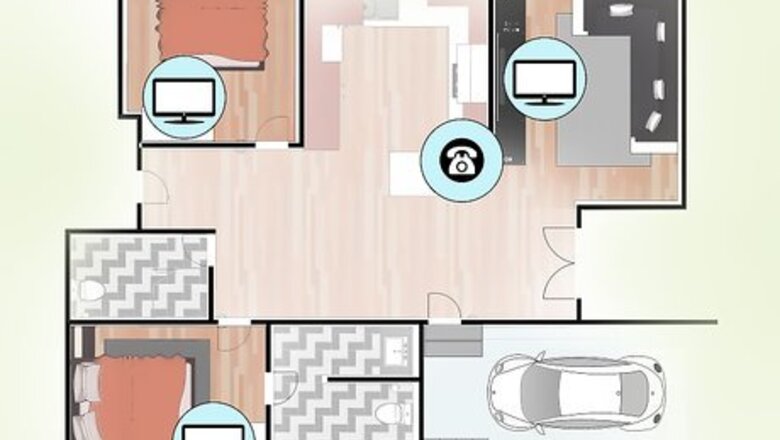
views
Drawing Up a Wiring Plan

Identify the rooms that need a cable hookup. Plan the path for your wires before starting any work. First look at the plan of your house and identify the rooms that require a cable hookup. Generally, any rooms that will have a TV, landline phone, or computer need one. Some contractors like to run wires into every room, just in case. That way, if you decide you want a cable hookup in another room, later on, you don’t have to run new wires. If you only use wifi for your internet access, then you won’t need ethernet cables in every room with a computer.
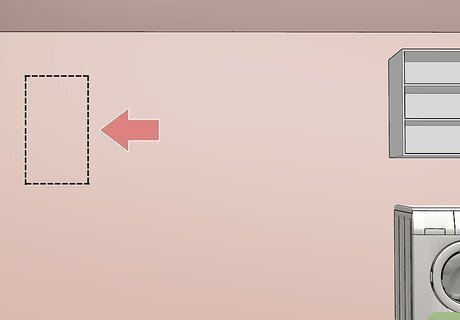
Position the wiring panel in a central location you can easily access. The wiring panel is where all your home’s network wires connect and where service providers attach their wires to. For the best location, look for a point in your home that is out of the way and where you can easily run wires to. Contractors usually prefer to put these boxes in the basement if you have one, because it’s easy to run the wires up through the walls and to other rooms. Another popular choice is a laundry room. Wiring panels can also be unsightly, so consider locating it in a closet or a room that visitors don’t enter. Wiring panels are also sometimes called structured wiring panels or distribution boxes. Don’t get confused if a website or contractor uses one of these terms.

Identify the route of the wires from your distribution panel. Cables commonly feed throughout the house from either the attic or the crawlspace under the house. Since not all homes have a crawlspace, the attic is a more popular choice. Go to your wiring panel location and make sure there are hollow walls there that you can run wires up. Most sheet rock walls should be suitable. Find a point in this area that you can feed a wire straight up into the attic from. You don't need precise measurements for running these cables. If the cable ends up too long, you can just cut or roll it when it reaches the end of its route. The wiring plan gives you a general idea of the route the wires will take, and also marks cable locations for future repairs. Check the blueprints of your house for potential routes that you aren't aware of. You can use existing holes in the wall to run cables as long as they don’t have electrical wires running through them. Electrical wires will interfere with the signal. If all the holes have electrical wires, then you’ll have to drill new ones.

Map out where each cable will go from the attic or crawlspace. Cables distribute throughout the house from the attic or crawlspace. Make a plan of all the rooms that need a cable hookup. Then map how each cable will feed through the attic and at which points they will enter each room. Cables usually feed down from the attic inside walls. For an easier, but less visually-appealing job, you can also cut through the room's ceiling and feed the cable down this way.
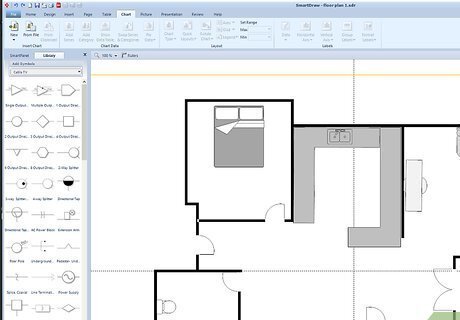
Use a program to draw a wiring plan if you don't know where to start. If you have trouble drawing up your own diagram or using your home blueprints, search for a software program to help. There are many products that let you scan in your home blueprints and plug in which cables you want to install. The programs then produce the ideal wiring plan for your home that you can follow easily. Some programs are free and some are paid. Research different ones to see which is best for your needs. Don't try to skimp by using a cheap program if it isn't a quality one. Some paid programs offer free trials that you can use to plan one job. See if a program you're interested in offers a trial.
Constructing the Distribution Point

Turn off the power. While you won’t be working with live cables, you will be drilling into walls where electrical wires could be. Stay safe by turning off your home’s power before starting work. Find your breaker box and turn the main switch off to cut your home’s power.
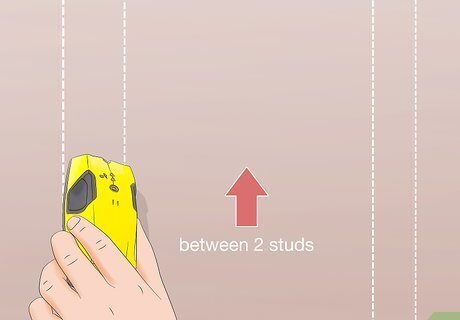
Locate the studs where your wiring panel will be. The wiring panel should be between 2 wall studs. Find the studs in the wall by sliding a stud finder along the wall. Mark on the wall where the 2 studs are, and work in the space between them. If you don't have a stud finder, tap on the wall. If you hear a hollow sound, there is no stud at this point. A sharp, quick sound indicates that you've tapped on a stud. This isn't exact, but it gives you an idea of where the studs are located.

Cut a 4 in (10 cm) by 4 in (10 cm) inspection hole between the studs. When you've chosen a point for your wiring panel, make sure the wall section has empty space behind it with no obstructions. Draw a 4 in (10 cm) by 4 in (10 cm) square on the wall. Then use your drywall saw and cut away this square section. Look inside with a flashlight for any wires or pipes. If you see pipes or other wires behind the wall, then use a different section. Don’t worry about the damage to your walls. You can patch drywall later after the job is done.

Cut away the drywall at your distribution point. When you've confirmed that there are no obstructions behind this wall, remove this wall section. Use a drywall saw to cut out the wall between the two studs. Start cutting at one of the stud points 2 inches (5.1 cm) down from the ceiling. Cut across the wall until you reach the other stud. Do the same for the bottom of the wall. Then cut vertically, connecting the two ends of the cuts you made. Remove this section of wall when you're done cutting. Drywall can be heavy, so have a partner nearby to help you lift the wall section out.
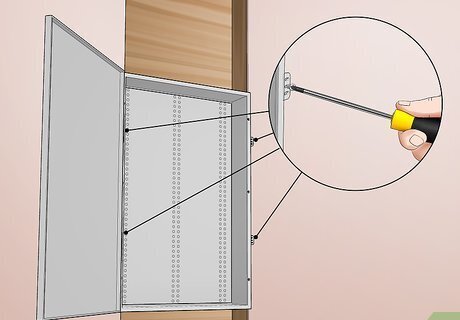
Install a structured wiring panel to keep your cables organized. Cables can just hang on the wall at the distribution point, but a wiring panel keeps them organized much better. If you want a wiring panel, purchase one from a hardware store. Then mount it in the wall section you just cut out. Hold the wiring panel up against both studs. Then use a power drill to screw the box to both studs. There are latches on the box to insert screws through. This job is easier with someone else holding the box up while you drill. A wiring panel is optional. If you want to save money, you don't have to buy one.
Cutting Holes for the Cables

Drill a 2.5 in (6.4 cm) hole through the top ceiling plate. When you open the wall, you’ll see a wood block running above the wall section. Use a boring drill bit 2.5 in (6.4 cm) in diameter. Press it against the ceiling plate and drill through it. If there is a floor below the panel that needs cable access, also drill a hole through the floor plate. Measure the distance from an external wall to the hole you drilled. This will help you find where to drill the attic hole if you can't find the point right above the distribution box.
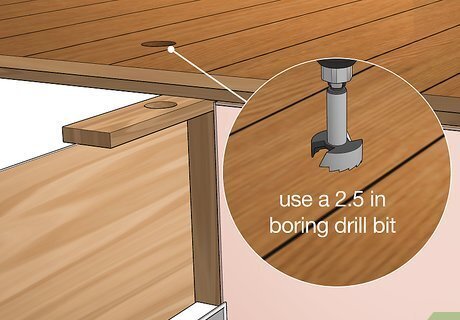
Drill a hole in your attic floor plate directly above the distribution panel. Go up to your attic and find the spot directly above where the distribution panel is. Then use the same 2.5 in (6.4 cm) boring drill bit and cut a hole through the floor plate. Attics usually have double plates, so you may have to drill through 2 blocks of wood to create the hole. If you can't find the distribution point, use the measurement you took when you drilled the first hole. Run your tape measure from the same external wall and find that distance in the attic. Drill at this point. If your attic has loose fiberglass insulation, wear a dust mask to avoid breathing in any particles.

Drill access holes above the rooms you’re running cables to. While still in the attic, find the areas above rooms where you need cable access. Use the 2.5 in (6.4 cm) boring drill bit and make holes. The cables will exit the attic through these holes.
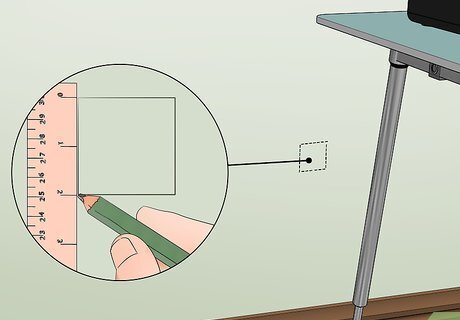
Mark cutting holes in the rooms that the cables will feed into. Go into each room that you’ll run a cable to. Then find the location where you want your cable outlet. Then use a ruler and draw a 2 in (5.1 cm) by 2 in (5.1 cm) box on the wall. Do this in each room that you need cable access in. If you know where the appliances will be in this room, then mark the holes near this location. Otherwise, locate them near an existing electrical outlet. Check for studs behind the wall before picking a location. Make sure you cut in an area with no studs.

Cut out the box you drew on the wall. Use a drywall saw and cut through the lines you drew on the wall. Remove the square of drywall when you’ve cut all the way around. Repeat this for every room that you’re running a cable into.
Feeding Wires through Walls
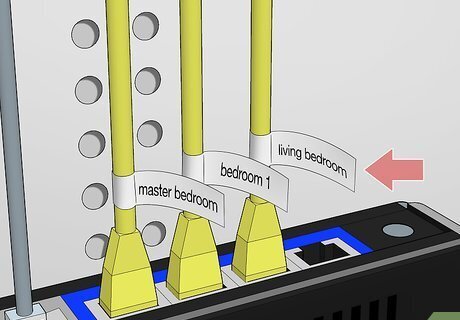
Label the locations for all the wires you’re running. Since all cables feed outward from your distribution panel, mark each one so you remember its destination. Wrap a piece of white tape around each wire. Use permanent marker and write where this cable feeds to. For example, write TV room, office, and bedroom on the cables. Labeling also makes repairs much easier. If a wire goes bad, you know right away which wire you should pull from the distribution box.

Feed your cables up the wall into the attic space. Feeding the wires up and down is usually a 2-person job. One person pushes the wire through the origin point and the other pulls through the hole at the destination point. Feed the wire through the hole above the distribution box while someone else pulls the from attic. Repeat this process for every wire you’re installing. Fish tape is the best product for making this job easier. Feed it down the hole from the attic until the person at the distribution box can grab it. Then have them attach the wire to the end of the fish tape. Pull the fish tape up while the other person feeds the wire and work it through the hole in the attic. Another home remedy if you don’t have fish tape is taping the wire to a piece of string and using that to pull the wire up. Work cables through the walls gently. Don’t pull or jerk them if they get stuck, or you could tear them.

Run the wires through the holes above their respective rooms. When you’ve run all the wires up to the attic, then bring each one to the hole that it has to feed down through. Then to the opposite action—have one person feed the cables down through the hole to the destination while another person pulls the cable out from the wall. Use the fishing tape again to make this job easier. Keep the wires out of the way by taping them to the ceiling rafters in the attic. Do not staple them. Staples could damage the wires and also make replacing the wires difficult.

Pull the cables through each wall outlet that you cut. Complete the cable installation by pulling each cable through the outlet holes you made. From here, you can run coaxial cables to your appliances or install an outlet for ethernet cables. If you want to hide coaxial cables, try installing a wall cover that runs from the outlet to your appliance. These are available from hardware stores.

















Comments
0 comment